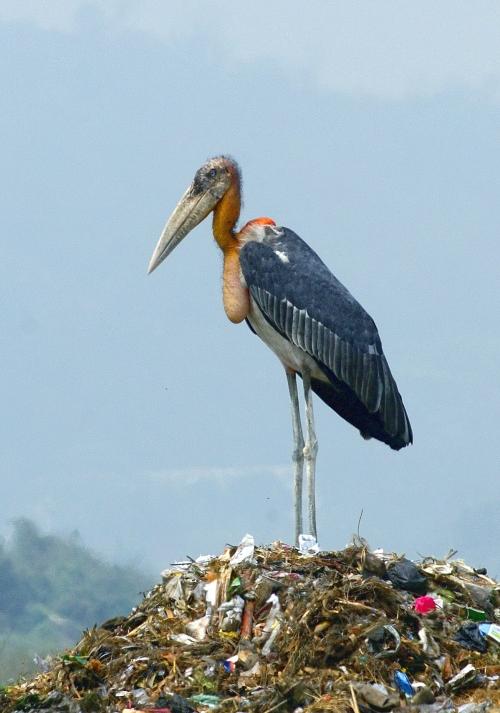adjudgeadjust
Adjuntant bird (English) [ IPA: Adjuntant ˈbərd ASM: এডজুটেণ্ট বাৰ্ড]
Contributed by: Biraj Kumar Kakati on 2007-12-21
 English: Adjuntant bird, Adjutant, Adjutant stork, Greater adjutant stork, Leptoptilus dubiussci ,
English: Adjuntant bird, Adjutant, Adjutant stork, Greater adjutant stork, Leptoptilus dubiussci ,
Assamese: হাদং, হাড়গিলা,
Dimasa: solagap
Adjuntant bird (English) [ IPA: Adjuntant ˈbərd ASM: এডজুটেণ্ট বাৰ্ড]
Contributed by: Biraj Kumar Kakati on 2007-12-21
1. Bird(Common Noun) Large mostly Old World wading birds typically having white-and-black plumage
The Greater Adjutant, Leptoptilos dubius, is a large wading bird in the stork family Ciconiidae. It formerly bred in southern Asia from Pakistan and India, Sri Lanka east to Borneo, but is now restricted to two separate small breeding populations; in Assam and Cambodia. In winter, this species migrates south to Vietnam, Thailand and Myanmar.
This is a huge bird, typically 145-150 cm (57-60 in) tall with a 250 cm (99 in) wingspan. There are no records of the weight of wild birds, but they may be the heaviest species of stork. Its upper body and wings are black, but the belly and undertail are off-white or pale grey. The pink head and neck are bare like those of a vulture. The yellow bill is long and thick. Juveniles are a duller version of the adult.
Most storks fly with neck outstretched, but the three Leptoptilos species retract their neck in flight like a heron.
The Greater Adjutant breeds in tropical wetlands. It builds a stick nest in trees and lays 2-4 eggs which are incubated by both parents for 28-30 days to hatching. It often forms small colonies.
The Greater Adjutant, like most of its relatives, feeds mainly on frogs and large insects, but also young birds, lizards and rodents. It will also eat carrion, for which its bare head and neck is an adaptation, and will feed in human refuse dumps.
Loss of nesting habitat and feeding sites through drainage, pollutions and disturbance, together with hunting and egg collection has caused a massive decline in the population of this species. The current population is estimated at less than 1,000.
ডিঙিত এটা মোনা ওলমি থকা এবিধ ডাঙৰ চৰাই । বগলীসদৃশ দীঘল ঠেঙৰ এজাতি চৰাই । পূৰ্বতে দক্ষিণ এচিয়া মহাদেশৰ পাকিস্তান, ভাৰত, পূৱ শ্ৰীলঙ্কাৰ পৰা মালয়েচিয়াৰ বৰ্ণিয়লৈকে বিয়পি আছিল । কিন্তু এতিয়া মাত্ৰ অসম আৰু কম্বোদিয়াতহে পোৱা যায় । শীতকালি ইহঁতে দক্ষিণৰ পৰা ভিয়েটনাম, থাইলেণ্ড আৰু ম্যানমাৰলৈ পৰিভ্ৰমণ কৰে ।
হাড়-গিলা ১৪৫-১৫০ ছে.মি.লৈকে ওখ আৰু ২৫০ ছে.মি. পৰিধিৰ ডেউকাৰে এটা ডাঙৰ জাতৰ চৰাই । শাৰীৰিক ওজনৰ কোনো সঠিক অভিলেখ পোৱা নেযায় যদিও সম্ভৱত বগলীবিলাকৰ ভিতৰত ই আটাইতকৈ ডাঙৰ । ইয়াৰ দেহৰ ওপৰ অংশ আৰু ডেউকা সাধাৰণতে ক’লা হয় । কিন্তু পেট আৰু ফিছাৰ তলৰ অংশ ধূসৰ বগা হোৱা দেখা যায় । শগুণৰ দৰে মূৰটো টকলা আৰু কমলা ৰঙৰ । ঠোঁটটো শকত দীঘল আৰু হালধীয়া ৰঙৰ । হাড়-গিলাই প্ৰায়বোৰ বগলী জাতৰ চৰাইৰ দৰে ডিঙিমেলি উৰি নেযায় । বৰঞ্চ ডিঙি কোঁচাইহে উৰে । হাড়-গিলাৰ বংশবৃদ্ধি সাধাৰনতে বিষুবীয় অঞ্চলৰ জলাশয়ৰ দৰে ঠাইত হয় । ই ওখ গছৰ ওপৰত গছৰ ডাল আদিৰে বাহ সাজি এবাৰত ২-৪ টালৈকে কনী পাৰে । কনীৰ পৰা পোৱালী জগিবলৈ প্ৰায় ২৮-৩০ দিন সময় লাগে । হাড়-গিলাই ভেকুলী, ফৰিং, জ়েঠী, মৰা জীৱ-জন্ত আদিকে ধৰি গেলা-পঁচা বস্তুলৈকে ভক্ষন কৰে । বাহ সজাৰ উপযুক্ত ঠাই, খাদ্যৰ অভাৱ, প্রদূষণ আদিৰ উপৰি চিকাৰ আৰু কণী সংগ্ৰহৰ বাৱে হাড়-গিলাৰ সংখ্যা দ্ৰুত হাৰত কমি গৈছে । বৰ্তমানে ইয়াৰ সংখ্যা ১০০০ ৰো কম হ’ব বুলি ধাৰণা কৰা হৈছে।
হাড়-গিলা ১৪৫-১৫০ ছে.মি.লৈকে ওখ আৰু ২৫০ ছে.মি. পৰিধিৰ ডেউকাৰে এটা ডাঙৰ জাতৰ চৰাই । শাৰীৰিক ওজনৰ কোনো সঠিক অভিলেখ পোৱা নেযায় যদিও সম্ভৱত বগলীবিলাকৰ ভিতৰত ই আটাইতকৈ ডাঙৰ । ইয়াৰ দেহৰ ওপৰ অংশ আৰু ডেউকা সাধাৰণতে ক’লা হয় । কিন্তু পেট আৰু ফিছাৰ তলৰ অংশ ধূসৰ বগা হোৱা দেখা যায় । শগুণৰ দৰে মূৰটো টকলা আৰু কমলা ৰঙৰ । ঠোঁটটো শকত দীঘল আৰু হালধীয়া ৰঙৰ । হাড়-গিলাই প্ৰায়বোৰ বগলী জাতৰ চৰাইৰ দৰে ডিঙিমেলি উৰি নেযায় । বৰঞ্চ ডিঙি কোঁচাইহে উৰে । হাড়-গিলাৰ বংশবৃদ্ধি সাধাৰনতে বিষুবীয় অঞ্চলৰ জলাশয়ৰ দৰে ঠাইত হয় । ই ওখ গছৰ ওপৰত গছৰ ডাল আদিৰে বাহ সাজি এবাৰত ২-৪ টালৈকে কনী পাৰে । কনীৰ পৰা পোৱালী জগিবলৈ প্ৰায় ২৮-৩০ দিন সময় লাগে । হাড়-গিলাই ভেকুলী, ফৰিং, জ়েঠী, মৰা জীৱ-জন্ত আদিকে ধৰি গেলা-পঁচা বস্তুলৈকে ভক্ষন কৰে । বাহ সজাৰ উপযুক্ত ঠাই, খাদ্যৰ অভাৱ, প্রদূষণ আদিৰ উপৰি চিকাৰ আৰু কণী সংগ্ৰহৰ বাৱে হাড়-গিলাৰ সংখ্যা দ্ৰুত হাৰত কমি গৈছে । বৰ্তমানে ইয়াৰ সংখ্যা ১০০০ ৰো কম হ’ব বুলি ধাৰণা কৰা হৈছে।

Assamese: হাদং, হাড়গিলা,
Dimasa: solagap
